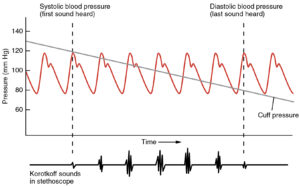Blood pressure
blood pressure The hydrostatic force that blood exerts against the wall of a blood vessel. This pressure is greatest during the contraction of the ventricles of the heart (systolic pressure), which forces blood into the arterial system. Pressure falls to its lowest level when the heart is filling with blood while at rest (diastolic pressure). BP varies depending on the energy of the heart action, the elasticity of the walls of the arteries, and the volume and viscosity (resistance) of the blood. BP rises and falls throughout the day.
When the blood flows through the vessels at a greater than normal force, reading consistently above 140/90 mm Hg (millimeters of mercury), it is called hypertension or high BP. High BP strains the heart; harms the arteries; and increases the risk of heart attack, stroke, and kidney problems. About one in every five adults in the United States has high blood pressure. Elevated BP occurs more often in men than in women. In African Americans it occurs almost twice as often as in Caucasians. Essential hypertension (hypertension with no known cause) is not fully understood. But it accounts for about 90 percent of all hypertension cases in people over 45 years of age.
Low BP is called hypotension and is an abnormal condition in which the BP is lower than 90/60 mm Hg. When the blood pressure is too low, there is inadequate blood flow to the heart, brain, and other vital organs.
An optimal BP is less than 120/80 mm Hg.





